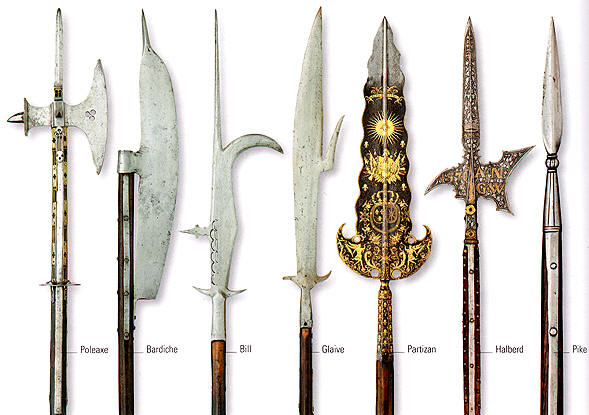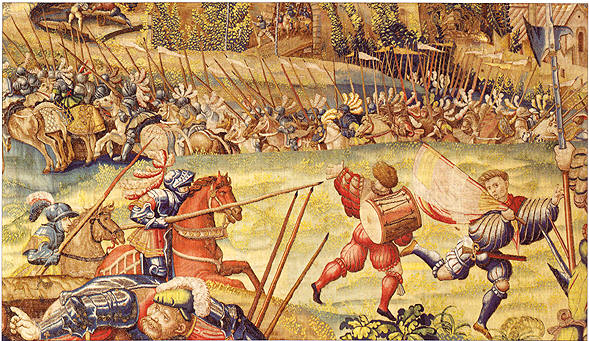Medieval Polearms
Massed formations of infantry
soldiers carrying polearms was a common sight on the
battlefields of Europe from the medieval period
right through to the early 1700's. The fighting part
of the polearm was placed on the end of a long shaft
and they were specially designed to disable and
inflict crushing injuries upon knights. Cheap to
produce in large numbers and versatile on the
battlefield, these weapons became the mainstay of
the European medieval foot-soldier when engaged in
close combat.

The Bardiche
A particularly brutal polearm
used extensively in medieval and Renaissance Europe,
the bardiche found particular favor in eastern
Europe and Russia. Blade design varied considerably
from country to country, but the main characteristic
was a substantial cleaver- type blade and attachment
to the pole by means of two widely spaced sockets.
Blade length was around 60cm (23.6in), although the
haft was unusually short at approximately l.5m
(4.9ft). This weapon appeared top-heavy and
impractical, but the bardiche was regarded more as a
heavy axe and wielded accordingly.
The Bill
With a tradition going back to
the Viking Age, the bill is commonly regarded as the
national weapon of the English both during and
beyond the medieval period, although it was used
elsewhere in Europe, particularly Italy. As with
many polearms, the bill developed from an
agricultural tool, the billhook, and displayed a
hooked chopping blade with several protruding
spikes, including a pronounced spike at the top of
the haft, resembling a spearhead. The bill also had
a strong hook for dismounting cavalry. Used
skillfully, it could snag onto any loose clothing or
armor and wrench the target from his horse and throw
him to the ground. English bills tended to be
shorter with the emphasis more on the chopping
action of the blade, while Italian bills had a very
long spiked end, resulting in its use as a thrusting
weapon.

ABOVE:
The battle of Pavia, 1525, between the Holy Roman
Emperor Charles V and Francis I of France. Note the
pikes and halberds (right).
The Glaive
Similar in design to the
Japanese naginata, the glaive originated in France,
and its single-edged blade was attached to the haft
by means of a socket shaft. Blade length was
typically around 55cm (21.6in), with a wooden pole
l.8—2.lm (5.9—6.8ft) long. Medieval Swedish infantry
adapted the glaive by fixing a double-edged sword
blade to the haft. Glaives with small hooks are
known as “glaive-guisarmes”.
The Halberd
The halberd is a crude,
rectangular blade, shaped to a point at the top; the
earliest known use of the halberd comes from an
excavated example from the battlefield at Morgarten
(1315) in Switzerland. The word “halberd” originated
from the German haim (staff) and barte (axe). Over
time, the halberd’s spear point was improved to
allow it to be used to repel oncoming horsemen. The
haft of the halberd was also reinforced with thick
metal rims, making it more effective and durable
when blocking blows from an enemy sword or axe.
The Partizan
Smaller than normal polearms at 1.8—2m (5.9—6.6ft),
the partizan was constructed from a spearhead or
lancehead, with an added double axehead at the
bottom of the blade. It proved not to be as
effective as other polearms and it was gradually
withdrawn from frontline use. It remained as a
ceremonial weapon and many have elaborately
decorated blades. Partizans were carried right
through to the Napoleonic Wars (1804—15).
The Pike
A ubiquitous battlefield weapon during the medieval
period, the pike was simply a very long, thrusting
spear employed by infantry as both a static
defensive weapon against cavalry attacks and as an
attacking polearm, when used in massed ranks and
close formation. The combined length of both haft
and head rose over time to a staggering 3—4m
(9.8—13.lft), sometimes even 6m (19.6ft), and it was
this very length that was both its strength and also
its inherent weakness. The pikeman could stand at a
relatively safe distance from close combat, but the
weapon’s unwieldiness could also prove dangerous for
him. A pikeman was armed with sword, mace or dagger
in case his pike was lost in battle.
|